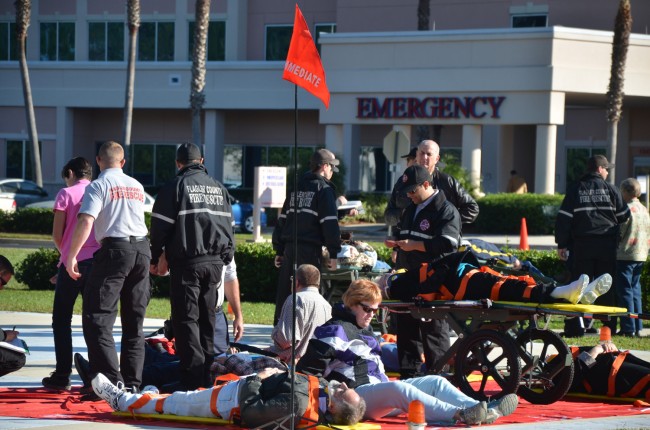
The last time Flagler County’s first responders put on a drill this extensive was around 2007 when they simulated a school bus accident t at the airport, with 37 casualties, including children and elderly.
Wednesday morning, the simulated casualties were all sprawled on the pavement and sidewalks of Hospital Drive, near the helipad by the Emergency Room entrance. They’d been blown up. A twin-engine plane equipped to carry 100 gallons of jet fuel had crashed at the county airport with four people on board. “Upon impact,” the exercise scenario reads, “which was approximately 100 feet from a small restaurant at the airport, the plane exploded. All four people on the plane are dead. There were approximately 40 people in the restaurant.” Debris had flown into the restaurant (presumably, Hijackers’), triggering all sorts of mayhem, including burns, smoke inhalation, people doused in fuel, trauma, eye irritation.
In all, the training scenario had 30 people killed or injured, all of them played by volunteer actors culled from county emergency or hospital staff families. (The number dropped to 29 when one of the actors got mildly sick, for real, during triage; she was excused and stayed, after being attended to by paramedics, as an observer.) “You want to get that broad range of patients because a lot of the elderly people already have different medical problems,” Flagler County Fire Chief Don petito said, shortly before the exercise began. “They might not be a trauma but now they’re having chest pains or they might be having trouble breathing, so you throw that into the mix thinking they’re going to get trauma, now they have a medical. Then the pediatrics are a totally different animal than an adult.”
Florida Hospital Flagler organized the full-scale drill and told county officials about it only late last week, so they had very little time to prepare, and, according to a hospital spokeswoman, didn’t tell hospital staff about it until the drill started this morning, to preserve the element of surprise. (Media were expressly excluded as hospital officials opposed county suggestions that media be present as observers. But it was the hospital’s exercise.) It was, in the technical wording of the drill, a “Decontamination and MCI Exercise,” MCI standing for “Multi-Casualty Incident.”
An “MCI” event is anything involving five or more casualties. They’re not exactly rare, as when several vehicles are involved in a big wreck. Flagler’s most notable such event was the p[lane crash into a house in January 2013, which killed three people who’d been in the plane and initially spread fears that many more people were injured. That turned out not to be the case, but the initial response, swift and zone-flooding, was that of a mass-casualty incident.
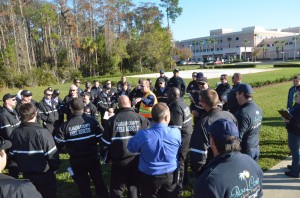
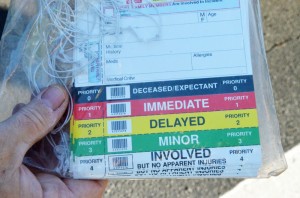
“So we both worked together in the same capacity,” Bennett said. “Everything went through us. We set up, we made the initial notification to dispatch, let them know that an aircraft was down, there was a large amount of fire that went into Highjackers, we set up command post, we set up our different sectors, treatment, triage, transport, staging, all the components of the structure that we need to do the job.” (Observers from other agencies, including the Jacksonville Fire Department. The Sheriff’s Office’s Jim Troiano, Jerry Forte of the Palm Coast Fire Department and Mike Bazanos of Flagler County Fire Rescue were also present.)
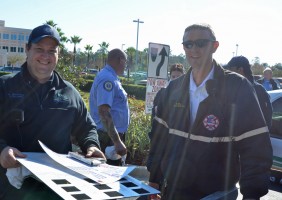
Whenever the commanders at a command post would need something, they reach for Guthrie, who has the authority to mobilize resources and either dispense them or withhold them, as needed. Theoretically today, four emergency helicopters and a much greater number of ambulances than the seven usually on standby in Flagler would have been involved, as was the county’s MCI truck.
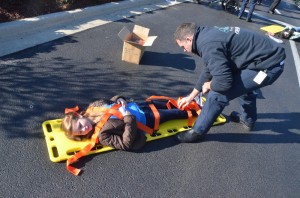
The exercise had three distinct steps, Guthrie said. First, the treatment, triage and transport by fire rescue personnel. The second component was decontamination, which was entirely the hospital’s responsibility: hospital personnel set up a blue shower tent outside the emergency room, where patients would be decontaminated then placed on stretchers and taken to the emergency room.
“I can’t really speak to how things are going to happen in the emergency room because that isn’t really our area of expertise for the exercise, however it was originally designed that all 29 of these patients would go to the ER. Now, they are experiencing a little bit of day-to-day activity, real world activity, so we’re probably going to have to greatly reduce the number of patients that we simulate going into the emergency department, just because of where they’re at.” Guthrie added: “everybody is doing a good job. Of course there’s always going to be the case where we can improve, and that’s why we exercise, so we can find places where we can make improvements, do additional training. We’ll have a complete after-action report that we will do in concert with Florida Hospital and turn that over to them within a couple of weeks.”
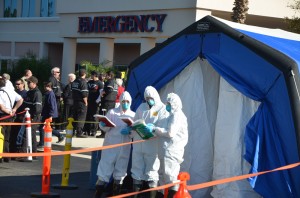
It was of course impossible to follow the action inside the hospital and get a clearer understanding of how and whether the emergency room is equipped to handle such an incident, despite attempts to gain access.
“This is not born from an attempt to keep you from reporting the success or failure of an important exercise to help us be ready in case of a real emergency,” Florida Hospital Flagler CEO Ken Mattison wrote in an email Tuesday evening. “ It is born out of the reality that at the same time as we will be conducting this drill, we will be caring for real patients and that is no place for members of the press or anyone else not involved with the drill or patient care.”
The training wrapped up before noon, in time for the hospital’s annual Christmas lunch with “lots of food for all to enjoy!,” as an email to staff put it.
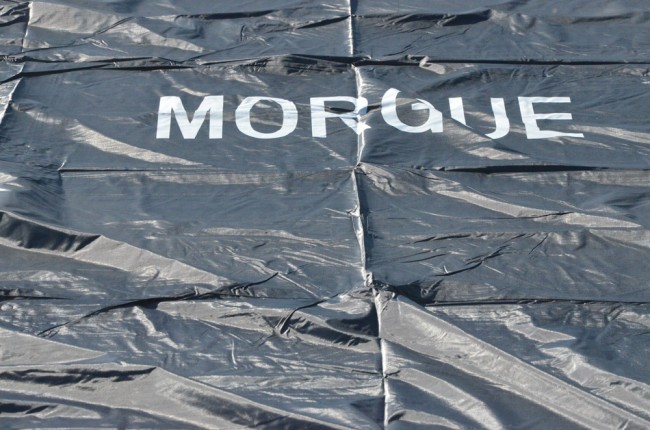





























NortonSmitty says
Hey, didn’t I see that one-legged guy at the Boston Bombing video?
Gomez & Mortisa says
I want one of those MORGUE tents. The kids will love it . Great Christmas gift for the young ones. They can set it up in the house.